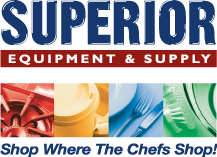Posted on December 14 2023

Did you know that fifteen million Americans have a food allergy? Did you also know that allergic reactions account for 200,000 emergency room visits a year? According to another study, in the United States alone, a reaction to a food allergy sends someone to the emergency room once every three minutes. That’s why it is crucial to ensure proper food safety practices are followed and to take every measure to avoid cross–contact.
The degree of severity for allergic reactions vary from person to person, but in worst case scenarios, death can occur. If a guest has a severe allergic reaction, the costs for your business could quickly add up, from negative media exposure to loss of reputation and customers, legal fees, lowered staff morale, and more. In 2008, a prominent quick-service sandwich chain was sued after a teenager with a severe peanut allergy died as a direct result of cross-contact when a knife used to cut a peanut butter cookie was used to prep her sandwich.
If proper practices are neglected, cross-contact could quickly happen in your operation. It’s important to know the most common allergens to watch out for and how cross-contact can occur. We’ll also cover appropriate actions to be taken to prevent it from happening in your establishment.
The Big 8 Most Common Food Allergies
What is a food allergen? The definition of an allergen is a specific protein in a food or ingredient that certain people have a sensitivity to. According to the Food and Drug Administration, there are more than 160 food items that can cause an allergic reaction. However, just eight of these items account for 90 percent of all reactions in the United States. These include:
Milk – milk allergies are the most common allergy among children; those with milk allergies should avoid milk in all forms, including dairy products in general.
Soy – foods including imitation dairy food, bean sprouts, soy sauce, soy protein like tofu. Soy is also a key ingredient in a lot of pre-packaged foods that might be used during food prep.
Wheat – many people have a gluten sensitivity or Celiac Disease, an immune reaction to eating gluten which is the protein found in bread, triggering a response in the small intestine.
What is Cross-Contact and How Does it Occur?
Cross-contact occurs when allergens are transferred from food or food-contact surfaces to the food served to the customer. This isn’t to be confused with cross-contamination, which is when dangerous pathogens that can cause foodborne illness are transferred to ready-to-eat foods. Cross-contact can occur in several ways. A couple of common examples include:
Cooking different types of food in the same fryer oil. For instance, if you fry shrimp in the same oil as chicken fingers, those with a crustacean shellfish allergy could be severely impacted. Peanut oil is also a popular type of cooking oil used in fryers across the country. One best practice is to have a fryer with peanut oil, and a separate one that uses canola for allergy-related special orders. Read more about commercial fryer solutions here.
Allowing food to touch surfaces, equipment or utensils that have touched allergens. A relevant example is using the same surface to prep chocolate chip cookies that was previously used to prep peanut butter cookies without properly cleaning and sanitizing first. Cross-contact can readily happen, but it can also be prevented if you remain aware of your surroundings.
Preventing Cross-Contact and Avoiding Food Allergy Reactions in Your Operation
Onset times for allergic reactions vary, depending on the person. In some cases, reactions are instant while in others, the symptoms may not come on until several hours after consumption. Some common symptoms include nausea, shortness of breath, hives or rashes, swelling, abdominal pain, itchiness, and more. Some symptoms may start out as mild irritations but can progress quickly. In extreme cases, anaphylaxis – a severe reaction that can lead to death – may occur.
Your best defense is proactivity. Food labels should clearly identify any allergens present in the product or ingredient used in its production. Federal law requires any of the Big 8 Allergens to be explicitly called out on the label.
Your service staff is your greatest asset in preventing an allergic reaction. Prior to taking the order, wait staff should always ask customers if there are any allergies the kitchen staff should be made aware of. Whenever prompted, they should be able to describe how dishes are prepared and identify key ingredients adequately. They should be thoroughly prepared to suggest other menu items that do not contain the food the customer is allergic to and clearly communicate the allergen to the kitchen staff when submitting the order so that food handlers know to prep it separately from other dishes. Before delivering the meal, service staff should confirm which one was the special order and bring it to the table separately.
Best practices for Avoiding Cross-Contact:
Confirming recipes and ingredients do not contain any of the common allergens.
Wash, rinse and sanitize all cookware, utensils, and equipment before prepping food. Some operations use separate supplies, like color-coded utensils and cutting boards just for allergen special orders (traditionally, the color purple is used to indicate supplies that should be used for these types of orders).
Ensure products containing an allergen do not come into contact with anything to be served to customers with food allergies, including other food equipment, gloves, beverage utensils, equipment, etc.
Wash hands and change gloves when switching tasks and before prepping food.
Label food packages onsite for retail sale, clearly calling out all major allergens.
Check out our Crash Course on Food Safety for more best practices, and our Resource Center with leading tips and insights to running an efficient operation.


0 comments